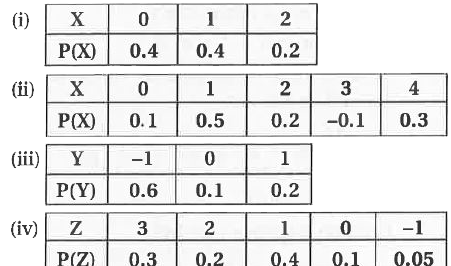Complete Solutions to EXERCISE -13.4 of chapter PROBABILITY of Class 12 book with complete answers and questions
| Class 12 | MATHS |
| Chapter | PROBABILITY |
| KUMAR PRAKASHAN | EXERCISE -13.4 |
| Number Of Questions | 20 |
| Academic Year | 2023-24 |
State which of the following are not the probability distributions of a random variable. Give reasons for your answer.
 01:54View Solution
01:54View SolutionAn urn contains 5 red and 2 black balls. Two balls are randomly drawn. Let X represent the number of black balls. What are the possible values of X? Is X a random variable ?
01:51View SolutionLet X represent the difference between the number of heads and the number of tails obtained when a coin is tossed 6 times. What are possible values of X ?
02:21View SolutionFind the probability distribution of
(i) number of heads in two tosses of a coin.
(ii) number of tails in the simultaneous tosses of three coins.
(iii) number of heads in four tosses of a coin.05:24View SolutionFind the probability distribution of
(i) number of heads in two tosses of a coin.
(ii) number of tails in the simultaneous tosses of three coins.
(iii) number of heads in four tosses of a coin.05:24View SolutionFind the probability distribution of
(i) number of heads in two tosses of a coin.
(ii) number of tails in the simultaneous tosses of three coins.
(iii) number of heads in four tosses of a coin.05:24View SolutionFind the probability distribution of the number of successes in two tosses of a die, where a success is defined as
(i) number greater than 4
(ii) six appears on at least one die03:34View SolutionFind the probability distribution of the number of successes in two tosses of a die, where a success is defined as
(i) number greater than 4
(ii) six appears on at least one die03:34View SolutionFrom a lot of 30 bulbs which include 6 defectives, a sample of 4 bulbs is drawn at random with replacement. Find the probability distribution of the number of defective bulbs.
03:47View SolutionA coin is biased so that the head is 3 times as likely to occur as tail. If the coin is tossed twice, find the probability distribution of number of tails.
02:17View SolutionA random variable X has the following probability distribution:

Determine (i) K (ii) `P(X lt 3)` (iii) `P(X gt 6)` (iv) `P(0 lt X lt 3)`04:04View SolutionThe random variable X has a probability distribution P(X) of the following form, where k is some number :
`P(X)={{:(k, "if " x=0),(2k, "if " x=1),(3k, "if " x=2),(0, "otherwise"):}`
(a) Determine the value of k.
(b) Find `P (X lt 2), P (X le 2), P(X ge 2)`.02:03View SolutionFind the mean number of heads in three tosses of a fair coin.
01:42View SolutionTwo dice are thrown simultaneously. If X denotes the number of sixes, find the expectation of X.
02:27View SolutionTwo numbers are selected at random (without replacement) from the first six positive integers. Let X denote the larger of the two numbers obtained. Find E(X).
03:47View SolutionLet X denote the sum of the numbers obtained when two fair dice are rolled. Find the variance and standard deviation of X.
03:20View SolutionA class has 15 students whose ages are 14, 17, 15, 14, 21, 17, 19, 20, 16, 18, 20, 17, 16, 19 and 20 years. One student is selected in such a manner that each has the same chance of being chosen and the age X of the selected student is recorded. What is the probability distribution of the random variable X? Find mean, variance and standard deviation of X.
04:01View SolutionIn a meeting, 70% of the members favour and 30% oppose a certain proposal. A member is selected at random and we take X = 0 if he opposed, and X = 1 if he is in favour. Find E(X) and Var (X).
02:22View SolutionChoose the correct answer
The mean of the numbers obtained on throwing a die having written 1 on three faces, 2 on two faces and 5 on one face is01:51View SolutionChoose the correct answer
Suppose that two cards are drawn at random from a deck of cards. Let X be the number of aces obtained. Then the value of E(X) is02:48View Solution
EXERCISE -13.4 questions and complete solutions for chapter PROBABILITY of KUMAR PRAKASHAN KENDRA MATHS (GUJRATI ENGLISH) of Class 12
All Exercises from KUMAR PRAKASHAN Class 12 MATHS PROBABILITY
- EXERCISE -13.1
- EXERCISE -13.2
- EXERCISE -13.3
- EXERCISE -13.4
- EXERCISE -13.5
- MISCELLANEOUS EXERCISE 13
- Multiple Choice Questions (MCQs)
- Practice Paper - 13 (Section - A (Choose the correct option))
- Practice Paper - 13 (Section - B (Answer the following questions))
- Practice Paper - 13 (Section - C (Answer the following questions))
- Practice Paper - 13 (Section - D (Answer the following questions))
- Practice Work
- Solutions of NCERT Exemplar Problems (Fillers)
- Solutions of NCERT Exemplar Problems (Long Answer Type Questions)
- Solutions of NCERT Exemplar Problems (Objective type Questions)
- Solutions of NCERT Exemplar Problems (Short Answer Type Questions)
- Solutions of NCERT Exemplar Problems (True/False)
- Textbook Illustrations for Practice Work
